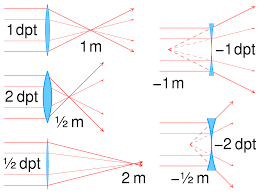The power of a lens, denoted by the symbol “P,” is a measure of its ability to refract (bend) light. It is specifically used to describe the focusing strength or the ability to converge or diverge light rays. The power of a lens is defined as the reciprocal of its focal length (f) and is measured in units called diopters (D). Power of Lens Formula :
The formula to calculate the power of a lens is:
P = 1/f
Where:
- P is the power of the lens in diopters (D).
- f is the focal length of the lens in meters (m).
The power of a lens can be positive or negative, indicating whether the lens is converging or diverging light, respectively.
A positive lens has a converging power, meaning it brings parallel light rays closer together to a focal point after passing through the lens. Examples of positive lenses include convex lenses, which are thicker in the middle and thinner at the edges.
A negative lens has a diverging power, meaning it causes parallel light rays to spread out as if they are coming from a virtual focal point before reaching the lens. Examples of negative lenses include concave lenses, which are thinner in the middle and thicker at the edges.
The power of a lens is an important concept in optics and is used in various applications, such as eyeglasses, contact lenses, microscopes, telescopes, and camera lenses. It determines how light is bent and focused, allowing for the correction of vision problems or the manipulation of light rays in optical instruments.

The focal length of a lens is the distance between the lens and the point where parallel light rays converge or appear to converge after passing through the lens. The focal length can be positive for a converging lens (a lens that brings parallel light rays together) or negative for a diverging lens (a lens that spreads out parallel light rays).
The power of a converging lens is positive and the power of a diverging lens is negative. The greater the power of a lens, the more it bends light and the shorter its focal length. The unit of measurement for lens power is diopters, which are defined as the reciprocal of the focal length in meters.
Example
An example of the power of a lens formula is as follows:
Suppose you have a converging lens with a focal length of 0.2 meters. To calculate the power of the lens, you would use the formula:
P = 1/f
P = 1/0.2
P = 5 diopters
This means that the power of the lens is 5 diopters, which indicates the degree to which the lens can bend light. A lens with a higher power would have a shorter focal length and would bend light more strongly than a lens with a lower power.
Important Links